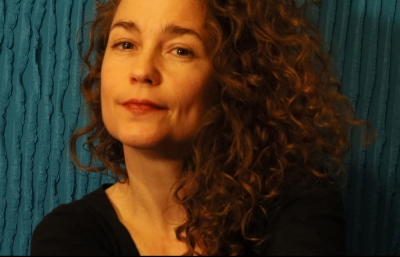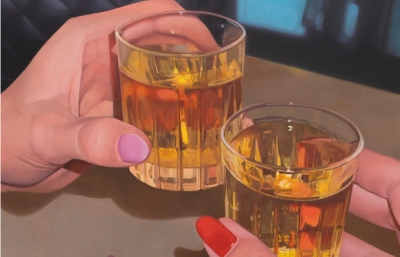There is an image from Carolyn Drake’s series, Wild Pigeon, of three men, shovels in hand, passing in front of a water-filled ditch. Into the distance figures move to and fro, across and over mounds of rocks and dirt, silhouetted by the textures of a pocked desert landscape. Animals, figures, and structures drawn on the surface of the photo hint at something more personal, though; stories, history, culture, and a shared but quickly changing relationship with the land. Like many of Drake’s photographs, there seem to be multiple conversations happening at once, conscious and subconscious, between photographer and subject, subject and place, place and time
There is an image from Carolyn Drake’s series, Wild Pigeon, of three men, shovels in hand, passing in front of a water-filled ditch. Into the distance figures move to and fro, across and over mounds of rocks and dirt, silhouetted by the textures of a pocked desert landscape. Animals, figures, and structures drawn on the surface of the photo hint at something more personal, though; stories, history, culture, and a shared but quickly changing relationship with the land. Like many of Drake’s photographs, there seem to be multiple conversations happening at once, conscious and subconscious, between photographer and subject, subject and place, place and time. With Wild Pigeon, a series about Uyghurs living in a remote region in far west China, and Internat, devoted to young women marked with disabilities at a Soviet-era orphanage in Ukraine, Drake began to invite the people she was photographing to color, cut, sew, and draw on the work. “I hope the collaborations encourage the images to be studied,” she explains, “to question the dynamic, and conflict, between author and subject—rather than be simply gazed at.”
Drake lived in Istanbul until returning to the U.S. in 2014, frequently traveling to work on projects in Central Asia, China, and Ukraine. “I certainly haven’t experienced home as a very fixed or stable thing,” she admits, “neither in my personal life nor generally, as I have experienced it in the world. In a way, it's liberating—because it allows for the possibility of transformation, the possibility of imagining other ways things can be.” Her current home in Vallejo, California, a historically blue-collar community on the San Francisco Bay, has, for better or worse, remained uniquely isolated from the floods of money, people, and tech reshaping the Bay Area. Drake’s work over the last few years has focused on this new, but not so foreign, home. She carefully depicts its characters; their stories suspended in a state of photographic limbo, unsure if they are moving forward or backward.
For Drake, shooting in America has been a huge adjustment—not just in her process, but as it relates to the social geography of this country, public and private spaces, and building connections. Looking at the work, we are given room to pause and consider each scene, the people, the place, and the ongoing conversations she and they are having with one another about the flow of life. —Alex Nicholson
“The balance between pre-conceiving and improvising is something I'm always working on, or working through. It's a struggle. If it goes too much in one direction, it doesn't work. I usually start with a general idea in terms of subject and approach. That is then bolstered by the readings I find before I start shooting. But then, oftentimes, the approach and subject shift significantly along the way.”
“In college, one of the early texts I read was John Berger’s Ways of Seeing. That and other readings related to visual culture drew me into the study of how images work on people. It completely transformed my way of seeing films and the range of other imagery that's always spinning around us, including real life. What you see is not just what you see but something to read and interpret.”
“In general, as for many people, photography as part of life fascinated me as a young person, beginning with family photo albums that I loved to pull out of the cabinet and flip through from time to time to share with new friends and boyfriends. There was something strange and alluring about inviting someone new in your life to view a time or period of you that they weren’t there for.”
“For me, being on the edge is largely about being able to step back and put myself outside myself, outside the situation I'm in so that I can start dissecting or deconstructing it, to try to have some perspective on what it means, try to see it in a different way. But then I like to come back in, with that distance in mind, and continue to work from the inside. I'd like to think the collaborations add another dimension to the work. They ask for a different kind of reading, interrupting the expected photographic narrative. I hope the collaborations encourage the images to be studied—to question the dynamic and conflict between author and subject—rather than be simply gazed at.”
carolyndrake.com
This article, with additional images here, was originally published in the Fall 2018 issue.










